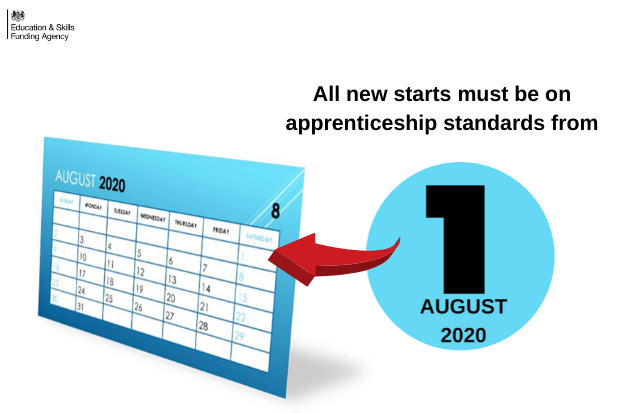Apprenticeship frameworks will soon be replaced by new apprenticeships standards on 1 August 2020. Find out how employers and providers are already seeing the benefits of moving to standards.
Annabel Basford works in the apprenticeship standards, workforce, and public sector policy team.
I have previously blogged about preparing for apprenticeships frameworks to be withdrawn on 31 July 2020 and all new apprentices starting their apprenticeship on standards from 1 August 2020.
A core part of our team’s work is to improve the quality of apprenticeships. Employers have told us that frameworks aren’t meeting their needs, are overly complex, and don’t always demonstrate that an apprentice is able to do the job at the end of their apprenticeship.
Apprenticeship standards have been designed by employers themselves to cover the knowledge, skills and behaviours required to succeed in an occupation. They now include independent end-point assessment to ensure that the apprentice is completely ready for the role at the end of their apprenticeship.
Finding a standard that works for you: employer experiences
Like many NHS Trusts, Leeds Teaching Hospital previously used the Business Administration Level 2 framework to train their entry level staff in a variety of roles including administration, HR, and finance roles.
As there isn’t a Business Administration standard at Level 2, they have had to rethink how they will recruit and develop staff in these roles.
They have started to use the Customer Service Level 2 standard instead, and Jordan Faithwaite (the Education, Learning and Organisational Development Manager at Leeds Teaching Hospital) has been blogging about their success:
“The Customer Service Level 2 apprenticeship standard has proven to be versatile and we have used it in a range of roles within corporate services and clinical settings. To make best use of this apprenticeship, learners have been encouraged and supported by the training provider to reconsider who a customer is within the trust, as it is not strictly always a patient. For example, working in HR, the customer could be a member of staff asking for support and advice.”
The trust has found that another benefit of using the Customer Service standard is that it continues to allow their employees to train in their administrative duties and also brings a new focus on the level and delivery of service and customer experience.
There may be other standards that will work better for your business if you are currently using the Business Administration framework at Level 2. For example there is a Business Administration standard available at Level 3.
More flexibility
West Sussex Council have found that apprenticeship standards offer their organisation more flexibility:
“We now have occupational training in a wider range of job roles and can easily tailor training to suit our business needs. As a result, our apprenticeship programme is growing at pace.”
The Royal Opera House have similarly found that standards can be adapted in a flexible way to meet their business needs:
“The new standards are designed so that they can be used by more than one industry, so that you can contextualise the curriculum and make them work for your business or your industry. Even if it doesn’t appear that there is one standard specifically for you at first glance, if you dig deeper and are innovative there is usually a way to make a standard work for you and your business needs”.
New opportunities
Chloe Warner from Saint Gobain UK and Ireland told us about the opportunities apprenticeship standards have offered both the business and their employees. Previously they were recruiting apprentices to traditional roles and have now found that the introduction of standards has enabled them to expand this offer:
“We have introduced around 16 programmes at all different levels in the last 18 months. In supply chain, IT, digital marketing, HR, and leadership and management. The way that new standards have been created by the Trailblazer employer groups and by industry experts has given us the flexibility to offer more enriched learning and development to our employees.”
A provider’s experience
One of the challenges training provider Kaplan found with moving from frameworks to standards was the change to staff roles. They had previously employed assessors but with the assessment element of standards now being independent of the provider, this role has changed. They have now successfully moved towards a staffing model more focused on coaches and tutors who can support apprentices to prepare for their end-point assessment.
Kaplan have found one benefit of standards is the focus on the individual and they now use the initial assessment of prior learning to set up a learning plan and targets that are personal to each apprentice.
Kaplan have said: “Overall the move to standards has been very positive for us and has been appreciated by our clients.”
Further resources
It’s exciting to see the positive impact apprenticeship standards are having on employers and providers.
I recently introduced a webinar with Richard Marsh from Kaplan. He has lots of useful advice for providers who need some guidance to fully transition to standards.
Employers have already developed over 500 standards. Search the full list of standards.
If you are an employer and you cannot find a standard which meets your business needs, please visit the Institute for Apprenticeships and Technical Education or email enquiries.ifa@education.gov.uk
